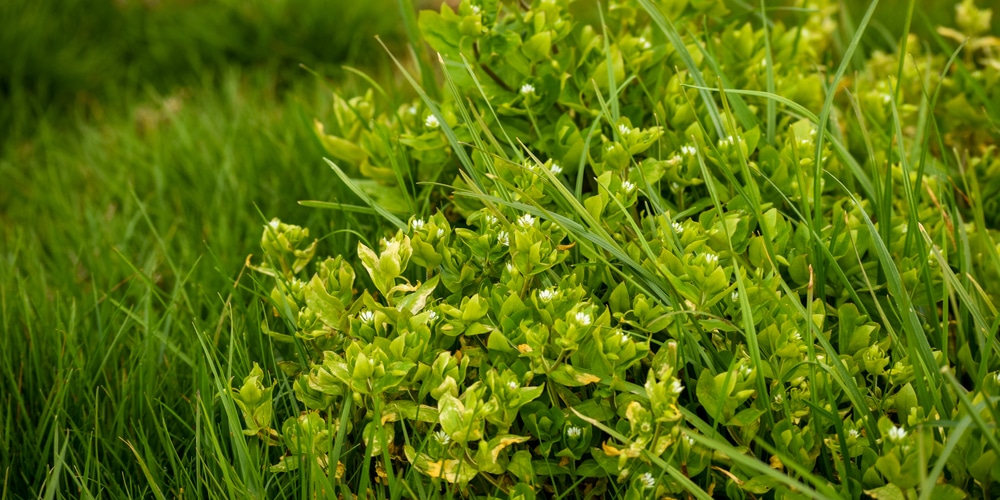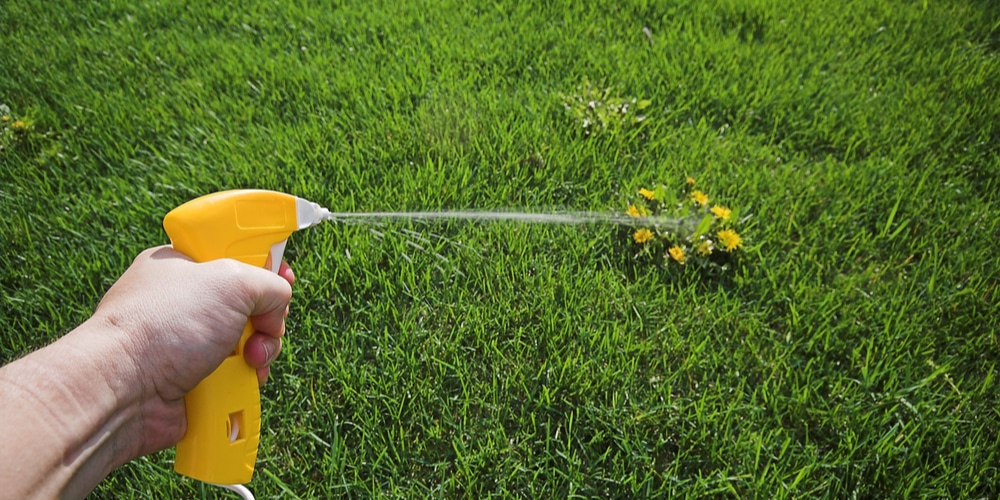Chickweed. One of the most loathed weeds by gardeners all over the world. This fast-growing, invasive plant can quickly take over gardens and lawns, smothering other plants in its path. If you’re struggling with a chickweed problem, you’re probably wondering how do you kill chickweed once and for all.
What is chickweed?
Chickweed (Stellaria media) is a common cool-season annual weed that often invades gardens and lawns. Native to Europe but now found in American lawns as well, chickweed thrives in cool, moist conditions. It has small, white flowers and opposite, ovate leaves that are about an inch long.
Chickweed grows close to the ground and can spread rapidly, forming a dense mat of foliage. This weed spreads at a fast rate through roots that emerge from stem nodes, which is why it is often difficult to control.
And despite being an annual plant, it still grows for the entire season. Plus, it has the ability to come from the flowering stage, produce seed, and germinate in just about five weeks. Still wondering why this weed is such a problem?
How Do You kill chickweed?
If you’ve encountered chickweed, it’s obvious that any homeowner would want to get rid of it as soon as possible. But how do you kill chickweed?
Chickweed is a tad difficult to control since it rapidly produces seeds and has an extensive root system. However, there are a few ways that you can effectively kill this weed:
1. Use vinegar
Vinegar works by dehydrating the plant and causing it to die. The vinegar solution needs to be at least 10 percent acetic acid in order for it to be effective. That’s why it’s recommended that you use horticultural vinegar as opposed to white vinegar.
About two cups of horticultural vinegar in a spray container should be enough to cover a normal-sized lawn. You will want to cover the weeds from the top to the bottom, so that you can get everything, including the nodes on the stems.
Just make sure to spray generously, and repeat your treatment if it rains, since rainwater will wash away the vinegar.
2. Cover with black plastic or tarp
This method is often used for larger areas that are infested with weeds like chickweed. The idea is to smother the plants so they can’t get any sunlight, which they need in order to grow. Weighing down the edges can also restrict airflow, increasing the rate at which the plants suffocate.
When using this method, it usually takes about 1-2 weeks for the plants to die. In addition to being ideal for larger gardens that have been taken over by chickweed, this method is also perfect if you don’t want to use chemicals.
You can easily find black plastic or tarps at most hardware stores.
3. Hand-pulling or hoeing
Thanks to the shallow root system of chickweed plants, this method is quite easy and effective when it comes to removing this weed from your garden. Hand-pulling works best when the soil is moist, so it’s best to do this after rain or watering your plants.
Make sure to get the entire plant, including the roots. If you leave any part of the plant behind, it will quickly regrow. Chickweed is a small plant, so this shouldn’t be too much of a problem.
If you don’t prefer hand-pulling, you can always use a hoe to loosen the soil around the plants and then pull them out.
4. Apply a herbicide
If you’re looking for an even quicker solution, you can always use an herbicide. The only caveat here is that you need to be careful about which herbicide you use, as some of them can damage your other plants. That’s why we have selective and non-selective weedkillers.
Selective herbicides
Selective herbicides are designed to kill specific weeds without harming your other plants. If trying to eliminate chickweed on a lawn with grass, a selective broadleaf herbicide should do the trick. Weedkillers that contain Dicamba and/or 2,4-D are best for lawns.
Non-selective herbicides
On the other hand, non-selective herbicides will kill any plant they come in contact with, so use these with caution.
Glyphosate is the most common non-selective herbicide, often used to kill weeds on walkways, driveways, and other areas where you don’t want any plants to grow.
You should only use non-selective herbicides for spot treatments, as they can quickly kill your other plants if you’re not careful.
Which is the best weedkiller for chickweed?
Eraser is the most effective weedkiller for chickweed, containing 41% Glyphosate. This weedkiller works systematically by killing the plant from the foliage down to the roots. After application, chickweed plants should start dying in just a matter of days.
As a non-selective herbicide, however, Eraser will quickly kill any plant it comes in contact with, so make sure to use it with caution. Spot treat only the areas that are infested with chickweed and avoid contact with your other plants.
You can also use an indicator dye like Vision Pro Max to help you see where you’ve sprayed and prevent accidental contact. It’s also important to measure the treatment area in square footage so that you can establish clearly just how much product you need.
When using Eraser for spot treatments, 2.5 oz. of the product mixed with a gallon of water should be enough to cover 300 sq. ft. As for the amount of dye that you should use, a rate of 6-10 fl. oz. per 100 gallons of Eraser solution should be perfect.
How Do You Kill Chickweed: To conclude
If chickweed has been a problem in your garden, there are a few methods you can use to get rid of it. Hand-pulling or hoeing work well if you don’t mind getting down on your hands and knees, but they can be quite time-consuming.
Applying a herbicide is usually the quickest solution, but you need to be careful about which product you use. Eraser is the most effective weedkiller for chickweed, but it’s also non-selective, so use it with caution.
Related Article: Little White Flowers in Grass


